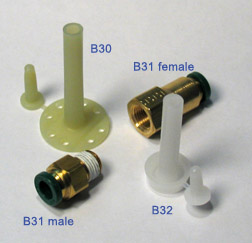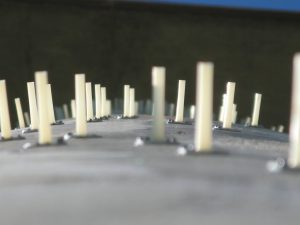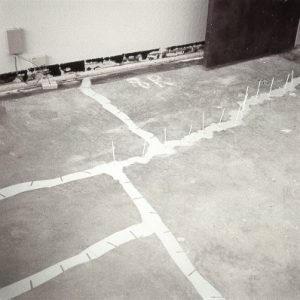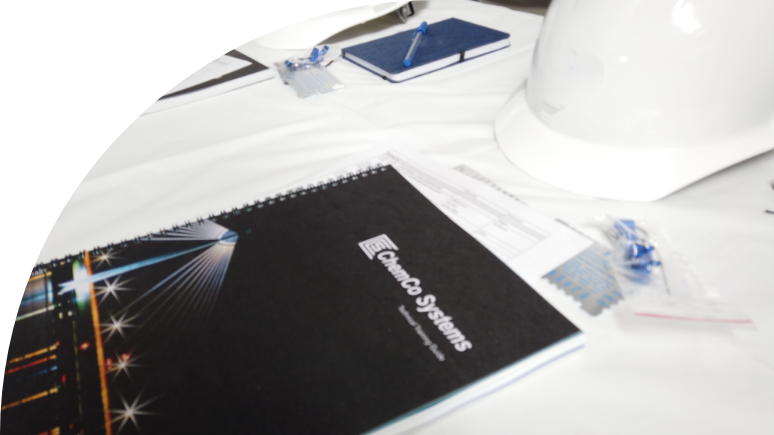Kemko® Epoxy Injection Ports
Surface Mount and Drill-In Ports and Connectors for Epoxy Injection Crack Repair
Epoxy Ports
The B30 Kemko® surface mount epoxy injection port is designed for use with most epoxy injection systems. Constructed of sturdy translucent nylon with a textured base, it offers superior adhesion (compared to polyethylene) to the epoxy seal so port blow-off is minimized. Integral with the port is a plug for port closure at no extra cost. Snap-off slots in the base allow for a closer fit in tight areas.
The B-32 inset (drill-set) injection port is designed for a pre-drilled 1/2″ deep by 1/2″ diameter hole. It has a sloped flange that will hold it in the hole in any orientation without additional adhesive. It is constructed of polyethylene for toughness and extra flexibility and will withstand hammer blows (or even limited vehicle traffic if necessary). It also comes with a press-to-fit cap.
To connect the either the B30 or B32 port directly to the Kemko® mixhead, use one of the B31 port adaptors that has a brass threaded 1/8″ NPT adaptor on one end and a press-to-fit connection on the other end. Most commonly, the female adaptor is used to connect directly to the male connection on the ball valve controlling the mixed epoxy flow from the mixhead.

Call for Pricing
Solution: StripSEAL for Structural Integrity and Surface Restoration
Do you always think about alternative porting methods as you prepare to execute a crack repair project?
Maybe not. Yet the method selected by your field technician may make a significant difference in the quality, linear footage productivity, substrate clean up and job profitability. With a goal of filling a crack quickly, neatly, and completely, several factors to consider are:
- Crack Width and Substrate Thickness
- Application Temperature and Moisture
- Orientation (Ceiling, Wall or Floor)
- SGross Linear Footage
- Access Limitations
- Surface Appearance After Repair
- Avg. Time on Port
- Type of Surface Seal Employed
- Aesthetic Concerns on Finished Appearance
Many of our customers use a combination of several porting methods:

Tape Low cost ports are established as gaps in the epoxy surface seal with quarter inch masking tape applied at the proper interval prior to the surface seal. The tape is pulled before the seal hardens completely. With hand pressure, the injection mix head contacts the open gaps left by the tape though a compressible rubber grommet by manual hand pressure holding the grommet (tip) in place. After the port is filled, bar soap or paraffin wax is rubbed over the crack to seal the port. This type/size of tape is typically found in professional paint shops.
Tips, pins, nails, (cocktail) straws, golf tees and toothpicks These alternatives to tape often require no drilling. Sometimes they are used in combination. For example, often rubber tips are located along the crack with toothpicks, (or pins or nails) prior to the seal application. To inject, the toothpicks are withdrawn and the mix head nozzle is inserted into the tip.
Surface ports Injection molded of various plastics or nylon, surface ports have become popular in the last 10 years. These consist of a flat base flange perpendicular to a tube for easy connection to the injection equipment using a press-to-fit connection. Although more costly, field technicians appreciate the benefit of not having to hold the injection head against the port, particularly on ceilings or when time on port (long duration on single port) will be high.
Drilled Ports for drilled holes (see B-32 above) are made to be tapped into pre-drilled holes. This method is one of the first choices when injection flows are obstructed by the type of crack, surface obstructions, plugging, or for accessing voids under a sound surface (such as a de-bonded topping slab). If the crack is narrow, a water-flushed core bit is superior to an impact bit as it is less likely to fill the crack around the hole with drill.
Please call us to discuss your options. We’ll promise to give you our best answer based on over 50 years solving epoxy injection and concrete repair challenges. Don’t be surprised if the answer comes from a project in 1967!

Tell us about your project
CALL 650-261-3790.

